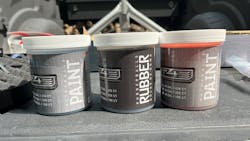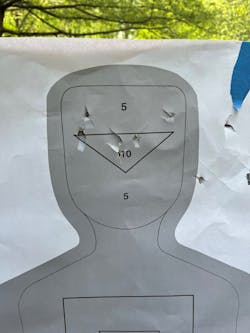The Officer Media Group editorial team was recently contacted to perform a field test and evaluation of T4E training platforms (www.t4eguns.com), specifically as they applied to training for law enforcement professionals in force-on-force training scenarios. We received three S&W M&P markers and one HDX shotgun marker from T4E. Upon receipt, we unpacked them along with the supplied CO2 cartridges, paint ball supplies and rubber ball supplies. There were also spare magazines for the M&Ps along with necessary cleaning supplies for the shotgun.
This article appeared in the March/April issue of OFFICER Magazine. Click Here to subscribe to OFFICER Magazine.
In our experience, the first requirement of any force-on-force training weapon is that it will not chamber or fire live ammo. The M&Ps absolutely cannot chamber live ammo, much less feed it, and the shotgun marker can’t be loaded with normal 12g ammo no matter how hard you might try. These training weapons can only be loaded with the appropriate caliber of paintball, rubber ball or powder ball.
The second requirement of quality force-on-force training tools is that their form, fit and function is as close to identical to the real weapon as possible. In other words, if your duty weapon is a S&W M&P 2.0, you don’t want your training weapon to be a generic paintball gun. You want your training weapon to be the same size as your duty weapon, with the same mechanical controls, fitting in the same holster. The only notable difference between the T4E M&Ps and a real S&W M&P is the capacity: the marker M&Ps hold eight .43 caliber paintballs per magazine. There are reloadable magazines and they fit in your magazine pouch for realistic training.At ranges of 5 to 7 yards, all hits on a paper target were within six to eight inches. That is sufficient for training purposes. The shotgun gave greater accuracy to longer distances but once past about 20 yards we saw the paint balls start to do some interesting things like turns, spirals, etc. The paint balls are excellent for force-on-force training and the pain penalty when hit is notable. It’s about the equivalent of being hit by a “normal” paintball. During our training, several marker impacts on the trainers were made and there was no denying when someone was hit. The paintballs reliably broke, leaving easy to see orange or blue paint marks, or white powder marks. If you’re training in an area where you can’t make a mess, the rubber balls provide an equivalent pain penalty without the color marking and attached mess. It is not recommended that you engage at less than 10 feet with the handgun markers and not less than 15 feet with the shotgun marker.
As training tools, the Officer Media Group gives these marker weapons two thumbs up. They receive our “Tested— Field Rated” Officer Review Labs seal of approval.
This article appeared in the March/April issue of OFFICER Magazine.






